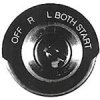kgruber
Final Approach
I asked this same question 20 years ago on Avsig, and JD and RS didn't have an answer then.
Randy thought it was a hold over from 70 years ago and had something to do with a radial engine. John just scratched his head.
But, to this day, there is no logical reason to mag check in this manner. In fact, just: both...left...right...both is not only faster but gives better information, in that left and right are consecutive and the drop between them is more easily recognised. Also, less chance of leaving it on one mag.
Both...left...right...both!
Quicker, faster, and saves time.
Randy thought it was a hold over from 70 years ago and had something to do with a radial engine. John just scratched his head.
But, to this day, there is no logical reason to mag check in this manner. In fact, just: both...left...right...both is not only faster but gives better information, in that left and right are consecutive and the drop between them is more easily recognised. Also, less chance of leaving it on one mag.
Both...left...right...both!
Quicker, faster, and saves time.





